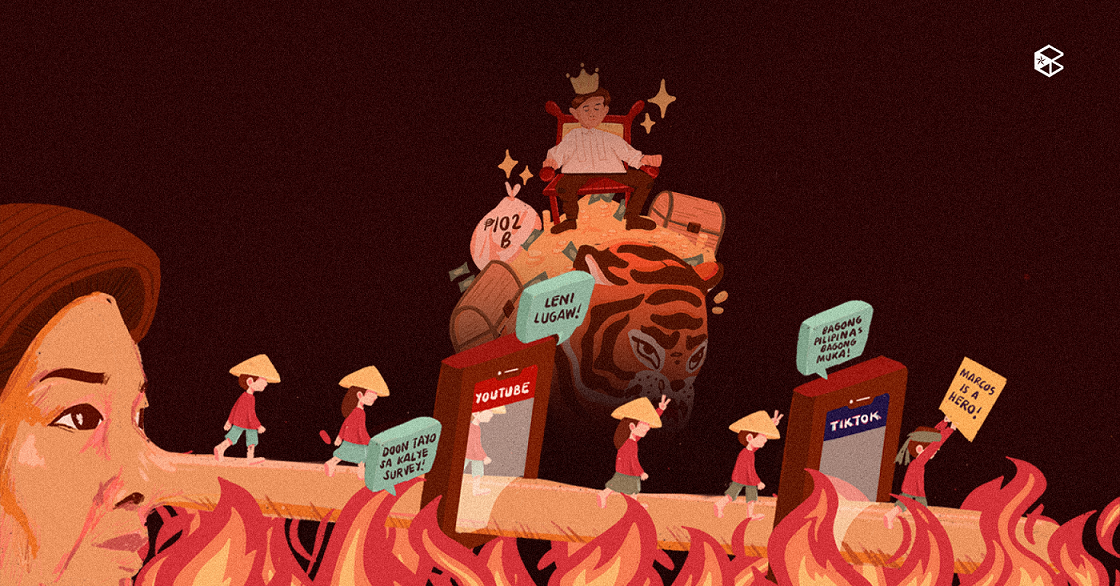From a dishonorable exile in 1986 to the national seat of power less than a century later—Filipinos bore witness to one of the most unprecedented and historical phenomena to transpire in national history: the outrageous return of the Marcos dynasty into the government and the decades-long disinformation campaign that conspired to put them there. However, Filipinos find themselves not only experiencing the same bleak reality, but a shared fault and complacency that allowed it to happen.
A Marcos masterplan
While President Ferdinand “Bongbong” Marcos Jr.’s shocking landslide victory caused much civil outrage in its aftermath, it wasn’t completely unpredictable.
In fact, it had only proven how his campaign’s intricate and damaging propaganda had massively succeeded in rebranding the Marcos family name from plunderers to seemingly “royalty.” Through the span of mere decades, the brutal history of martial law had gone through a major overhaul, so much so that millions of Filipinos believe that the Marcoses had ushered in a “golden age” of economic prosperity for the country.
Yet this false narrative is, by no means, anything new. The Philippine Center for Investigative Journalism (PCIJ) detailed an online campaign released in 2012 that had christened the late dictator Ferdinand Marcos Sr. as the “hero” that had “refused to fire upon the crowds” of the 1989 EDSA Revolution, crediting the title of EDSA’s “bloodless revolution” to Marcos Sr. More recent examples reported by Rappler uncovered a whole trove of Facebook pages and Youtube videos from 2014 to 2016, founded on ambiguous claims of the Marcos regime, exaggerating achievements and even going so far as to map out the so-called “Maharlika kingdom” that housed the infamous Tallano gold endowed to the Marcoses. In 2021, however, the Marcos camp had found a new tool to weaponize in the form of social media platforms such as video-hosting service TikTok, which, as of late, has become the primary breeding ground for historical revisionism.
Despite the skepticism surrounding allegations, however, the content managed to reach millions of Filipinos worldwide, deliberately leaving behind an irreparable trail of deception that would later manifest itself in the 2022 National Elections.
Yet, while it may be easy to point fingers, the truth of the matter is that everyone had a role in this twisted indoctrination of the so-called “Marcos fantasy” (coined by University of the Philippines-Diliman professor Victor Felipe Bautista), and we must be held accountable.
A lapse in collective memory?
As Ryan Flores of Inquirer.net affirmed in a column regarding post-EDSA revolution failures, “The promise of [the] ESDA [revolution] never extended beyond the ousting of Marcos. [...] Beyond that, it was up to you and the rest of your generation to build on what was left of our country. It was incumbent on you to pass along the lessons learned, so history would not repeat itself.”
Archives may detail the way millions of people had revolted against the tyrannical rule of Marcos Sr. on that fateful day in 1986, which marked a new age of justice and democracy for the nation. However, what Filipinos failed to do was further substantiate this movement and reinforce a unified front: to never allow the Marcoses to re-enter Philippine politics.
Indeed, what lies at the heart of this failure is the blatant neglect to inculcate future generations of the country’s past. An article by Inquirer.net assembled a comprehensive list of history textbooks from the K-12 curriculum that glossed over and “commercialized” the events of martial law in the country, some even going as far as to interpret that martial law was a “necessary” ruling made by a “benevolent” leader.
In 2020, two years before the beginning of his administration, President Marcos Jr. himself further provoked the idea of further rectifying and clearing his family name, accusing educational institutions of invoking “political propaganda” on the youth. While his statement was met with harsh criticism by the Commission on Human Rights (CHR) and various other organizations, with Vice President Sara Duterte now appointed as the next secretary of the Department of Education (DepEd), fears of widespread disinformation, revisionism, and even censorship loom over the country’s future educational curriculum.
One history, one truth
This unconcerned, false sense of security against the Marcoses clearly marked the beginning of the downfall of a democratic society that our people fought for merely 36 years ago. We realize now that there is no honor in silently allowing such transgression and treachery to wrap its fine-winding tendrils around the fabric of Philippine society, no dignity to be found in those who have attempted their hands from the guilt of their complacency, and no paradise for the bystanders.
Yet not all is lost—not when there are those who have not forgotten. Not when there are those who can break this poisonous cycle of indifference and complacency in society: the outraged, the wronged, and the deceived. Now stands the youth at the precipice of democracy, left to atone for the sins of those that came before them. A shared inheritance; a shared burden. Yet, as heavy as this burden may be—we must be there to heed the call.
The bells toll as we enter the eleventh hour of equality and justice in society; imploring you to question yourselves: in the face of abuse and oppression, will you choose honor or hypocrisy?
There has only ever been one version of our history, and there should only ever be one truth. And what years of oppression, ill-intentioned indoctrination, and historical revisionism have taken from us, we must reclaim it tenfold.
This article is also published in The Benildean Volume 8 Issue No. 2: Reacted.


